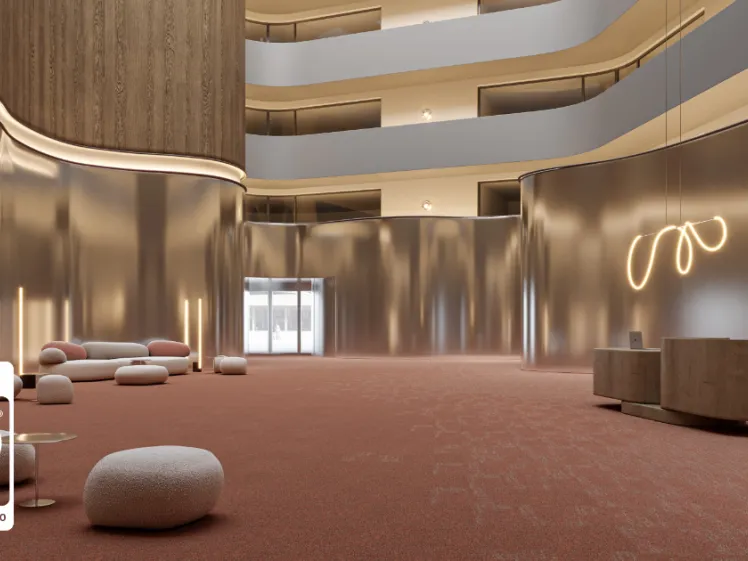
Lighting shapes mood, function, and atmosphere, creating spaces that inspire and perform. Paired with the right flooring, it transforms interiors into cohesive, impactful designs. From sustainable solutions to artistic lighting, these trends redefine how light enhances the spaces where we live, work, and connect.
Smart Lighting Systems
Complete control of these systems lies with the users, allowing them to set the mood, colour and brightness of the lighting to suit the functionality or ambience of the space. This can be done by the touch of a button or even via voice-command. Nowadays, these systems are often equipped with artificial intelligence capable of learning and predicting users' preferences, making adjustments automatically for optimal comfort and convenience.
Sustainable Solutions
Energy efficiency is key. By using light fixtures such as LED, known for their durability an low energy usage, energy consumption can significantly be reduced. Designing a building from scratch? Understanding the exterior environment is crucial. Research how natural elements like sunlight and weather conditions affect buildings in the area, and consider how your design can harmonise with these factors. With this knowledge, you can strategically position windows and skylights to maximise natural light and efficiency.
Biophilic Lighting Design
Biophilia is a design trend that has been gaining momentum the last couple of years. It seeks to recreate organic/natural elements within spaces aiming to connect occupants with the outside world. A couple of examples of biophilic lighting design are:
- Circadian rhythm lighting
- Skylights and light wells
- Dynamic daylight simulation
- Green walls with integrated lighting
- Natural material reflections
- Artificial “sun” fixtures
- Biophilic task lighting
- Lighting for outdoor-indoor transitions
- Shadow play
Faux Skylights
This artificial lighting installation mimics natural daylight coming from the ceiling, typically made of LED panels that diffuse a soft, natural light. These panels are often installed in spaces where natural light is limited or absent, such as basements, windowless offices, healthcare facilities, or underground transportation hubs. Some faux skylights also incorporate dynamic lighting features that change throughout the day, simulating the shifting tones of natural daylight, from crisp, energising morning light to warm, relaxing evening hues.
Invisible Lighting
Applying discreet lighting fixtures such as concealed LED strips and cove lighting helps to accentuate structural features without oversaturation. This minimalist approach crafts a soft and elegant atmosphere within spaces.
Human-Centric Lighting
Designing with a primary focus on the occupants is becoming more and more important every year. Even in the decision making of the lighting fixtures, people should be taken into consideration. It all starts with a profound understanding of the impact of light on human physiology and psychology, from how it influences mood and productivity to its role in supporting natural circadian rhythms.
Wayfinding and Zoning
Light becomes a tool to subtly guide people through a space and define its functional areas. In zoning, different lighting intensities, colours, or fixtures delineate specific zones, such as warm, ambient lighting for relaxation areas and brighter task lighting for workspaces. For wayfinding, linear light paths, illuminated signage, or contrasting light temperatures direct movement and provide intuitive navigation through complex spaces like airports, hospitals, or large retail environments. This approach not only enhances functionality but also elevates the user experience by creating visually cohesive and intuitive spaces.
Mood Lighting
Colour changing lighting systems have proven to be a rising trend in architectural lighting. It helps evoke specific emotions or set the tone of a space. Mostly implemented in smart lighting systems, mood lighting enables the users to personalise the mood in real-time whether through dimming, colour changes, or pre-programmed settings that adapt to different times of day or activities.
Artistic Lighting
Lighting design doesn’t always have to be just energy efficient, it can also be done creatively. Using lighting fixtures that stand as focal points in your spatial design sets the tone for unique experiences.
Whether you’re embracing smart systems, biophilic design, or bold artistic lighting, these trends offer endless opportunities to innovate.

Get a feel for our carpets

Get news and insights
Recent blog items

modulyss achieves Cradle to Cradle Certified® Gold under Version 4.0

From Grid to Flow: Designing Beyond Straight Lines

Perceptive Places: Shaping Smarter Interiors




